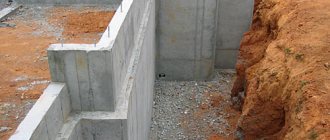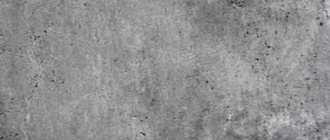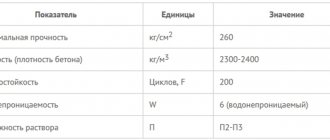M100 concrete is a type of heavy concrete characterized by a low “load” capacity and, accordingly, a limited scope of application. In some unreliable online publications, this building material is characterized as “light”. Actually this is not true.
Concrete grade M100 consists of “heavy” components and “submits” to the requirements of the current regulatory document - GOST 26633-2015 “Heavy and fine-grained concrete. Technical conditions".
Where is M100 concrete used?
The relatively small load-bearing capacity of this grade of concrete has determined a relatively limited scope of application. In particular, heavy concrete m100 GOST 26633-2015 is used in the following construction and concrete works:
- Preparatory concrete work.
- Repair of defects in concrete structures and structures.
- Construction of concrete floors in interior spaces.
- Arrangement of blind areas around private and office buildings.
- Construction of pedestrian paths in private and country houses.
- Installation of curbs and other road preparation work.
It should also be noted that in Soviet times, 7.5 m100 concrete was widely used as the main material for the construction of walls of one-story residential buildings, which are successfully used to this day, without any questions about strength and durability.
Therefore, if a private developer is faced with the task of erecting a one-story house building up to 3 meters high, the technical characteristics of M100 concrete will fully ensure the strength and durability of the structure, all other things being equal.
Classification of road concrete by purpose
Types of road concrete by purpose:
- Single-layer road surfaces, top layers of double-layer and multi-layer road pies. The water-cement ratio in such concretes is less than 1:2.
- Bottom layer in two-layer coatings. In this case, the ratio of water to cement in the concrete mixture is more than 3:5.
- The bottom layer of pavement for capital roads. The water-cement ratio for concrete mixtures used for the foundation of capital roads is not standardized.
Specifications
- Strength of concrete m100: 98 kg/cm2.
- Water resistance: W2-W4.
- Frost resistance: F50-F100.
- Mobility (workability): P2-P4.
- The average weight of concrete is m100: 2270 kg per 1 m3.
Conclusion. If a developer wants to use this building material as the main building component, he should make appropriate calculations for the strength that walls built from M100 class 7.5 concrete can withstand. As practice shows, private and country one-story houses built from M100 concrete have sufficient load-bearing capacity and durability to “stand” for up to 50 years or more.
Characteristics
The use of M100 concrete is explained by its technical characteristics, determined using laboratory tests. After research, documents are issued for a batch of solution confirming its properties. The main characteristics of class B7.5 concrete corresponding to the M100 grade include:
- The strength of the composition is 98 kg/cm² - one of the lowest indicators for this material.
- Density - from 2370 to 2400 kg/m³ depending on the fillers.
- Mobility - from P2 to P4 - can fill voids under its own weight.
- The rigidity of the composition is within the limits of Zh2-Zh4 - preservation of shape during installation.
- Water resistance is within W2-W4, therefore it cannot be used at high humidity, for the construction of structures in soil.
- Frost resistance within F50-F100 - this range depends on the use of additives.
- The volumetric mass indicator is 1840 kg.
Such parameters determine the wide scope of application of the M100 - from cushions under buildings to curbs and road surfaces. This type of concrete can be classified as a lightweight material in terms of specific gravity due to the use of special fillers such as expanded clay. Certain characteristics, such as mobility or frost resistance, can be adjusted with plasticizers and other additives.
Composition of concrete M100
Like other brands of heavy concrete, M100 consists of: granite or crushed gravel (filler), quarry or river sand, Portland cement CEM I 32.5N PC (M400) or CEM I 42.5N PC (M500) and clean fresh water. Due to the limited scope of application, additives are not added to this brand of concrete.
For lightly loaded structures (blind area, garden path, preparatory work) erected on private farmsteads, it is allowed to use slag formed by burning coal, broken bricks and other construction waste as filler.
Composition of road concrete
Fiber-reinforced concrete is often used as construction concrete. Concretes for road and airfield pavements are classified as heavy concrete, their density is 1800-2500 kg/m3, the content of binders in such concrete is reduced, which is why they are called lean.
Substances needed to produce road concrete: water, binder, fine and coarse aggregate. Sand acts as a fine aggregate, and basalt, less often limestone gravel or crushed stone is usually used as coarse aggregate.
The binder is hydrophobic and plasticized Portland cement. The content of C3A (trichalcium aluminate) in road concrete according to GOST should be less than 10%.
There is a special road Portland cement, it comes in two grades: M300 and M400, it has increased frost resistance, deformability, bending strength, resistance to impact loads, low shrinkage and abrasion.
According to standards, road concrete for highways must have frost resistance of F150, and for roads within the city - F100. Various modification additives provide the required frost resistance.
Gravel and crushed stone can be of different fractions. For the top layer of a multilayer structure, crushed stone or gravel with a diameter of 20 mm is used, for single-layer coatings - 40 mm. The grade of coarse aggregate should not be less than the values indicated in the table.
Sand can also be different. Typically fine to medium grain sand is used. To accelerate hardening, chemical additives – plasticizers – are added to concrete; the amount of additives should be less than 60 g/kg of cement.
Proportions of concrete M100
For the convenience of user-developers, we summarize the proportions of the components and their quantities required to prepare 1 meter of cubic material in the following table:
Table 1.
| Cement brand | Proportions C:P:SH:H | Number of components for preparing 1 m3 of concrete | |||
| Cement, kg | Sand, kg | Crushed granite, kg | Water, l | ||
| M400 | 1:4,4:6,8:1,1 | 175 | 755 | 1150 | 190 |
| M500 | 1:5:7,3:1,2 | 158 | 770 | 1150 | |
At a construction site, it is not always possible to measure concrete components in kilograms. Therefore, “by default”, when preparing a batch, developers use a universal “measure” - a “bucket”. That is, they measure the proportions of concrete in 100 m buckets. We bring the data in Table 1 to a “10 and 12 liter bucket” and summarize them in Table 2:
Table 2.
| Cement brand | Number of components for preparing 1 m3 of concrete in 10 liter buckets, pcs. | Number of components for preparing 1 m3 of concrete in 12 liter buckets, pcs. | ||||||
| Cement | Sand | Crushed stone | Water | Cement | Sand | Crushed stone | Water | |
| M400 | 13,5 | 54 | 82 | 19 | 11,2 | 45 | 68,5 | 15,8 |
| M500 | 12,2 | 55,3 | 82 | 10,1 | 45,8 | 68,5 | ||
When calculating the “buckets”, the following average reference values for the bulk density of materials were used:
- Cement: 1,300 kg/m3.
- Sand: 1,400 kg/m3.
- Crushed stone fraction 20-40 mm: 1,400 kg/m3.
Concrete is an artificial stone-like building material obtained as a result of molding and hardening of a rationally selected and compacted concrete mixture ( GOST 26633-2015 Heavy and fine-grained concrete. Technical conditions ). There are many varieties of concrete, from heavy structural to lightweight ( GOST 25820-2014 Lightweight concrete. Specifications (Reissue) ) porous concrete, incl.
with various fillers. Characteristics of concrete GOST 26633-91 Heavy and fine-grained concrete. Technical specifications (with Amendments No. 1, 2, with Amendment)) 1. The strength of concrete at a design age of 28 days (if the design age is not specified separately) is characterized by classes of compressive strength, axial tension, and bending tension:
- strength classes for compression: B3.5; AT 5; B7.5; AT 10 O'CLOCK; B12.5; B15; IN 20; B25; B30; B35; B40; B45; B50; B55; B60; B65; B70; B75; B80 . — axial tensile strength: Bt 0.4; Bt 0.8; Bt 1.2; Bt 1.6; Bt 2.0; Bt 2.4; Bt 2.8; Bt 3.2; Bt 3.6; Bt 4.0 . — tensile strength during bending: Btb 0.4; Btb 0.8; Btb 1.2; Btb 1.6; Btb 2.0; Btb 2.4; Btb 2.8; Btb 3.2; Btb 3.6; Btb 4.0; Btb 4.4; Btb 4.8; Btb 5.2; Btb 5.6; Btb 6.0; Btb 6.4; Btb 6.8; Btb 7.2; Btb 8.0 .
Before the entry into force of ST SEV 1406 (currently not in force) , the following grades of compressive strength were established: M50; M75; M100; M150; M200; M250; M300; M350; M400; M450; M500; M550; M600; M700; M800; M900; M1000 , where the number shows the strength of concrete in kgf/cm2. Grades were also established for axial tensile strength Pt and flexural tensile strength Ptb.
2. For concrete structures subject to alternating freezing and thawing during operation, the following grades of concrete are assigned according to frost resistance: F50; F75; F100; F150; F200; F300; F400; F500; F600; F800; F1000 . The number indicates the number of freeze-thaw cycles.
3. For concrete structures that are subject to requirements for limited permeability or increased density and corrosion resistance, waterproof grades are assigned. The following grades have been established for water resistance (exposure to water pressure in MPa on a prototype of a certain diameter): W2; W4; W6; W8; W10; W12; W14; W16; W18; W20 .
The relationship between classes of concrete in terms of compressive strength and grades (GOST 26633-91 Heavy and fine-grained concrete. Technical specifications (with Amendments No. 1, 2, with Amendment) and SNiP 82-02-95 Federal (standard) elemental standards for cement consumption in manufacturing concrete and reinforced concrete products and structures)
| Concrete class by compressive strength | The closest concrete grade in terms of strength |
| AT 2 | M25 |
| B2.5 | M35 |
| B3.5 | M50 |
| AT 5 | M75 |
| B7.5 | M100 |
| AT 10 | M150 |
| B12.5 | M150 |
| B15 | M200 |
| IN 20 | M250 |
| B22.5 | M300 |
| B25 | M350 |
| B30 | M400 |
| B35 | M450 |
| B40 | M500 |
| B45 | M600 |
| B50 | M700 |
| B55 | M700 |
| B60 | M800 |
| B65 | M900 |
| B70 | M900 |
| B75 | M1000 |
| B80 | M1000 |
Preparation of concrete
The type and grade of cement for preparing concrete should be selected in accordance with the purpose of the structures and their operating conditions, the required strength class of concrete, grades for frost resistance and water resistance, the value of the tempering or transfer strength of concrete for prefabricated structures based on the requirements of standards, technical specifications or
design documentation for these structures, taking into account the requirements of GOST 30515 , as well as the impact of harmful impurities in aggregates on concrete.
To prepare concrete manually at a construction site, you can use
table 7.18 given in the “Handbook of Construction Technologists”, 3rd edition by G.M. Badin .
It gives average values of material consumption per 1 m3 of concrete mixture. In accordance with SNiP 82-02-95 Federal (standard) elemental standards for cement consumption in the manufacture of concrete and reinforced concrete products and structures , crushed stone is used as aggregates for concrete (basic standards). When using gravel, they should be multiplied by the coefficients indicated in Table 6 .
Table 6
| Concrete class by compressive strength | B7.5 | B10-B12.5 | B15 | IN 20 | B22.5 |
| Coefficient | 0,91 | 0,94 | 0,96 | 0,97 | 0,98 |
Basic standards for heavy concrete provide for the use of aggregates with a maximum particle size of 20 mm . When using aggregates with other largest grain sizes, the coefficients indicated in Table 7 .
Table 7
| Largest grain size of filler, mm | Coefficient for concrete classes by compressive strength | |
| up to B25 inclusive | B30 and above | |
| 10 | 1,1 | 1,07 |
| 40 | 0,93 | 0,95 |
| 70 | 0,9 | 0,92 |
When selecting aggregates, it is recommended to ensure that sand, gravel or crushed stone has grains of varying sizes.
In this case, there will be almost no voids between the grains. And the fewer voids, the less sand is required and the consumption of cement will be reduced. For example, you can prepare a mixture:
- from two fractions - 50% - 40 mm and 50% - 20 mm ; - from three fractions - 40% - 40 mm , 30% - 20 mm and 30% - 10 mm .
To regulate and improve the properties of concrete mixtures and concrete, reduce cement consumption and energy costs, chemical additives that meet the requirements (air-entraining and plasticizing, gas-forming, antifreeze) should be used.
Basic rates of cement consumption were developed based on the conditions for preparing concrete using Portland cement grade 400 .
When using cement grades 300 and 500 , the basic rates of cement consumption are multiplied by the coefficients given in Table 4 .
Table 4
| Curing conditions | Design class of concrete for compressive strength | Tempering strength of concrete, % of design class | Conversion coefficient from grade 400 cement to grade cement | |
| 300 | 500 | |||
| Natural at positive temperatures | B15 and less From B20 to B30 B35 and more | 60-70 60-70 60-70 | 1,13 — — | 0,85 0,90 0,92 |
| Heat treatment | B20 and less From B15 to B30 B20 and less B22.5 and more | 60 and less 70-80 90-100 | 1,14 — — | 0,87 0,87 0,90 0,92 |
Example of calculating concrete proportions
It is necessary to prepare concrete
B-15 ( M 200 ) from binder M 500 , and crushed stone fractions of 40 mm - 50% and 20 mm - 50% for this from table 7.18 "Handbook of Construction Technologists", 3rd edition G.M. Badin , take the cost of materials to prepare 1 m3 of concrete mixture.
To prepare this concrete mixture you will need:
— Portland cement M 400 — 244 kg. ; — crushed stone — 1289 kg ; — sand — 659 kg.
M 400 is used to prepare the concrete mixture . We use grade M 500 , for this we need to 244 by the conversion coefficient between cement grades from Table 4 ( coefficient 0.85 )
244 x 0.85 = 207.4 kg of cement grade M 500 will be required to prepare 1 m3 of concrete mixture.
1. Find the volume m3 of each component
Average bulk density of binder - Portland cement = 1100 kg/m3 Average bulk density of sand = 1600 kg/m3 Average bulk density of crushed stone 20 - 40 mm = 1400 kg/m3
We get the volumes of the required components:
Portland cement - 207.4 / 1100 = 0.19 m3
Crushed stone - 1289 / 1400 = 0.92 m3
0.92 / 2 = 0.46 m3 0.46 x 0.93 (from table 7) = 0.43 m3 (crushed stone fraction 40 mm) 0.46 + 0.43 = 0.89 m3 (crushed stone fraction 20 and 40 mm)
Sand - 659 / 1600 = 0.41 m3
2. Determine the composition of the concrete mixture (cement: crushed stone: sand)
(0,19 / 0,19) : (0,89/ 0,19) : (0,41 / 0,19) = 1 : 4,68 : 2,15
We accept the composition of the concrete mixture in volumetric dosage:
1 : 4.7 : 2.2 (cement : crushed stone : sand).
The most used classes of concrete and their purpose
B-7.5 (M-100) - used as concrete preparation (laid in a thin layer on compacted soil or sand cushion before pouring foundations), for pouring floors, paths, etc., as well as for securing curb stones.
In road construction it is used as preparation for the main road surface. V-12.5 (M-150) - used for screeding floors, concrete sidewalks, pouring strip foundations and slabs for lightweight structures, as well as in the manufacture of FBS blocks and FL slabs.
V-15 (M-200) - used for screeding floors, pouring foundations in individual construction, blind areas, paths, making concrete stairs and platforms, as well as in the production of FBS blocks.
B-20 (M-250) - used for the manufacture of monolithic foundations, stairs, fence strips, paths, light-loaded floors.
B-22.5 (M-300) is a universal class of concrete that is used for the manufacture of all types of foundations, stairs, and retaining walls.
V-25 (M-350) - used in critical structures (foundations, columns, crossbars, monolithic walls, floor slabs, including hollow-core ones).
B-30 (M-400) - used for the construction of bridges, hydraulic structures, the manufacture of swimming pool bowls, as well as for the production of airfield slabs PAG.
B-35 (M-450) - used for the construction of dams, dams, heavy-duty bridges, subways, bank vaults and other special structures.
B-40 (M-500) - used for the construction of large-sized structures, high-rise buildings, hydraulic structures, launch pads for cosmodromes and other special structures.
B-45 (M-600) - used at chemical, space, hydraulic, defense and nuclear facilities. In structures operated under extremely difficult conditions.
Cost of concrete M100
The price of concrete prepared on your own consists of the cost of the components and the cost of electricity spent to operate the concrete mixer. If you prepare concrete according to the old method - on a sheet of iron, the last factor can be ignored. The last factor can be ignored. To calculate the cost of 1 m3 of M100 concrete, we will set the average prices for the most affordable Portland cement M400 packaged in 50 kg bags, quarry sand and granite crushed stone:
- Average cost of one 50 kg bag of M400 cement: 230 rubles.
- Average cost of 1 m3 (1.4 t) of quarry sand: 200 rubles. (0.14 rub./kg).
- Average cost of 1 m3 (1.4 t) of granite crushed stone: 1,750 rubles. (1.25 rub./kg).
Using the component consumption data from Table 1, we calculate how much the M100 solution prepared on our own will cost: (175/50)x230+(755X0.14)+(1150x1.25)=910+105.7+1437=2,453 rubles.
For comparison, the cost of M100 concrete ordered at a concrete plant is from 2,850 to 3,680 rubles, depending on the filler (gravel or granite) and the manufacturer. Due to the significant dependence on distance, the delivery of components and ready-mixed concrete was not taken into account.
Concrete grade M100, technical characteristics, composition, GOST, application
Main menu
M100 grade concrete refers to an artificial building material that is mixed with binding components = fine or coarse fillers. M100 grade concrete mortar is used in construction work, in laying roads, in the restoration of objects and various quick repairs. The mixture of several components and their ratio determine the finished product and its characteristics. M100 concrete is mainly used in the construction of private buildings. When prepared, ready-mixed concrete grade M100 must comply with the State Standard. On large construction sites, production is guided by State Standard Data in accordance with GOST No. 26633. And builders who do not have skills in preparing solutions are required to adhere to technical specifications and the following characteristics that represent quality must be taken into account:
Density - up to 2400 kg/cm2; Water resistance - W2-W4;
Frost-resistant class - F50-F100.
Ready concrete before complete hardening should have rigidity Z1-Z4 and mobility P1-P4. Thanks to fillers, the concrete solution is tested for frost resistance and water resistance. For example: - if the filler was limestone crushed stone, then the water resistance and frost resistance are much lower than a concrete mass consisting of granite crushed stone. The rigidity and mobility are checked by mechanical action or by its own pressure on the mass - how quickly the deposition occurs.
Composition of components for the production of 1 m3 of mortar: - cement m400 or m500 - 206 kg; — sand or mixture with gravel — 780 kg; — crushed stone from granite, gravel or lime — 1177 kg; - clean water approximately - 185 liters (depending on the desired thickness of the solution).
In the production of M100 concrete, only M400 or M500 cement and all kinds of additional components are used to give the product the necessary quality indicators.
Where is M100 concrete used?
For the manufacture of slab, strip or block foundations, M100 concrete is used as their base. Since the heavy class B7.5 concrete solution is capable of creating a unique “cushion” consisting of sand and fine gravel, after hardening it forms a stable platform for further laying of tiles, reinforced concrete blocks or monolith. In agricultural buildings, cellars and non-residential premises, primed floors are filled with concrete mixture m100. This concrete is used to construct parking lots and stops for vehicles. In urban road industries, curbs, pedestrian paths, playgrounds and sports grounds for children are cultivated. Also, reinforced concrete products that are not subject to high loads are made from this brand of concrete. The cost of concrete mortar m100 largely depends on the filler used and the addition of various means for its quality.
beton-expert.ru
Brands of road concrete
Road and airfield concrete is characterized by a class of compressive strength, designated by the letter B. The number next to the letter shows what load in MPA the material can withstand without collapsing. The grade (M) of concrete also characterizes the properties; the numbers next to the letter indicate the compressive strength in kgf/m2.
Most often, concrete B20 M250 and road concrete B15 M200 are used for constructing roads. In the manufacture of concrete slabs for the construction of airfield pavements, viaducts and bridges, road concrete grade B30 M400 is used, which is endowed with great strength, frost resistance, durability and wear resistance.











